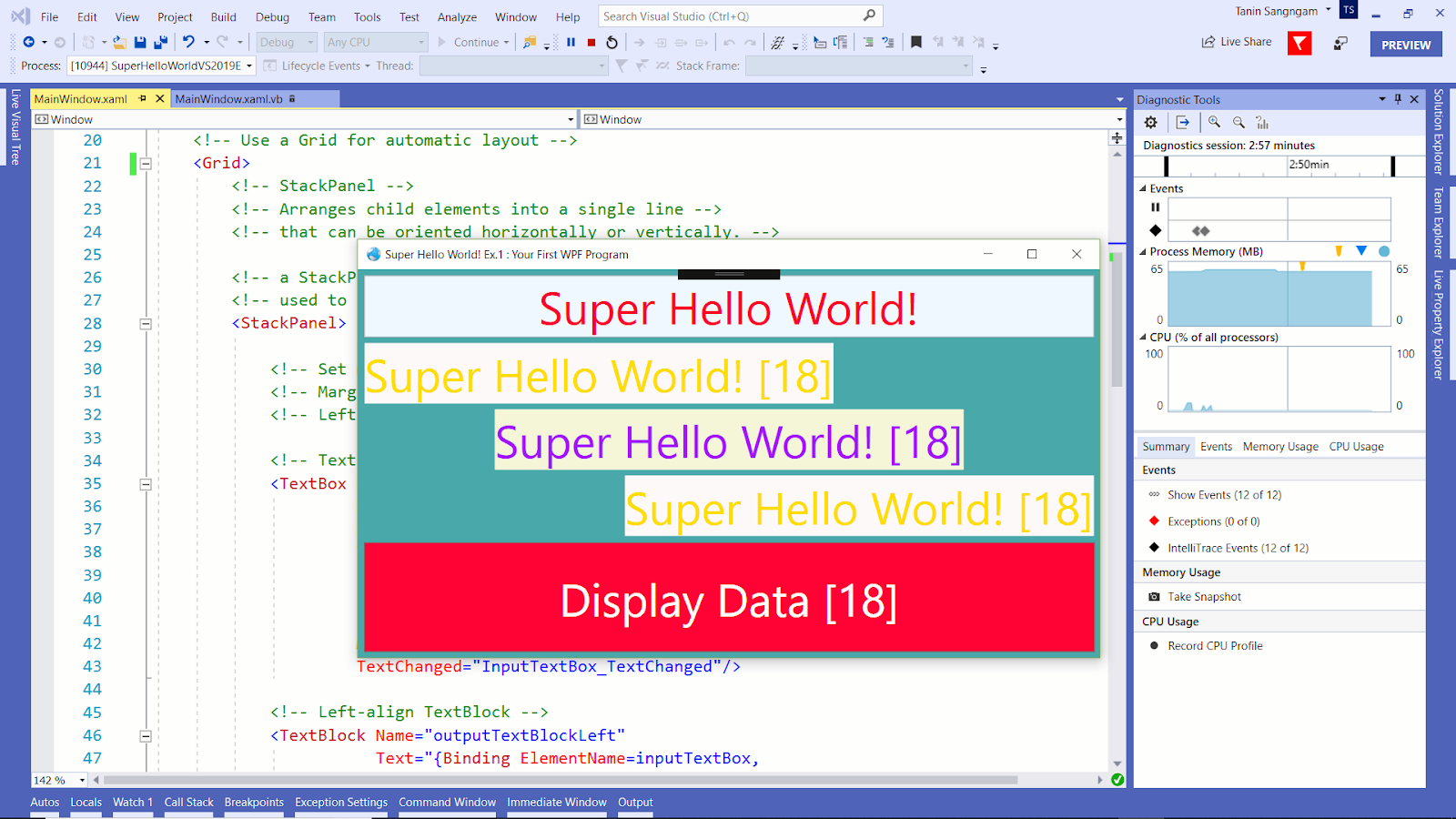By using Visual Studio, we can easily create a Hello World Program or Console Application in Visual Basic based on our requirements.
- Visual Basic Hello World Code
- Hello World Visual Basic
- Visual Basic Sample Code Hello World -
- Visual Basic Sample Code Hello World Paper
- Hello World Visual Studio
Hello World The simplest possible script. Println('hello world') # hello world With Julia installed and added to your path this script can be run by julia helloworld.jl, it can also be run from REPL by typing include ('helloworld.jl'), that will evaluate all valid expressions in that file and return the last output. Automatically Visual Studio will create the Demo Web Form and will open it in Visual Studio. Step 6) The next step is to add the code, which will do the work of displaying 'Hello World.' This can be done by just adding one line of code to the Demo.aspx file.
This example introduces you to the basic functionality of VS Code by demonstrating how to write a 'hello world' program in C. Before continuing, make sure you have the 'ms-vscode.cpptools' extension installed. Initialize the Project. The first step is to create a new project. To do this, load the VS Code.
In the previous chapter, we learned how to Download and Install Visual Studio on Windows Machine. In case, if you are not installed a visual studio, then follow the instructions to install visual studio otherwise open your visual studio.
Create Visual Basic Console Application
To create a new application in visual studio, go to Menu bar, select FileàNewà select a Project like as shown below.
Once you click on Project, a new popup will open in that select Visual Basic from the left pane and choose Console App. In the Name section give any name for your project and select appropriate Location path to save your project files and click OK like as shown below.
Once we click on OK button, a new console application will be created like as shown below. In case Module1.vb file not opened in your code editor, open the Solution Explorer menu in right side and double click on your Module1.vb file.
If you observe the above image, by default the application contains a Main() method because the console applications in visual basic will always start from the Main() method of program class.
Visual Basic Hello World Program Example
Now, replace your Module1.vb file code like as shown following to display the “Hello World” message.
Imports System
Module Module1
Sub Main()
Console.WriteLine('Hello World!')
Console.WriteLine('Press Enter Key to Exit.')
Console.ReadLine()
EndSub
EndModule
If you observe the above code, we used a lot of parameters to implement “Hello World” program in visual basic. In next section, we will learn all the parameters in detailed manner.
Visual Basic Hello World Program Structure
Now we will go through each step of our visual basic program and learn each parameter in detailed manner.
Imports System;
Here, Imports System is the .NET Framework library namespaces and we used Imports keyword to import system namespace to use existing class methods such WriteLine(), ReadLine(), etc. By default the .NET Framework provides a lot of namespaces to make the application implementation easily.
The namespace is a collection of classes and classes are the collection of objects and methods.
Module Module1
Here, Module Module1 is used to define a module (Module1). The module (Module1) will contain all the variables, methods, etc. based on our requirements.
Sub Main()
Here, Sub Main() is used to define a method in our module (Module1).
- The keyword
Subis a procedure and it is useful to write a series of Visual Basic statements withinSubandEnd Substatements. - The name Main will refer the name of our method in module (Module1). The Main() method is the entry point of our console application.
Console.WriteLine() / ReadLine()
Here, Console.WriteLine() and Console.ReadLine() methods are used to write a text to console and read the input from console.
The Console is a class of .NET Framework namespace System and WriteLine() and ReadLine() are the methods of Console class.
Compile & Run VB Hello World Program
To see the output of our Visual Basic Hello World Program, we need to compile and run the application by pressing either Ctrl + F5 or click on Start option in the menu bar like as shown below.
Once we click on Start option or Ctrl + F5, our program will get compiled and show the result like as shown below.
This is how we can create and execute the applications in visual basic (vb) programming language using visual studio based on our requirements.

The following console program is the Visual Basic version of the traditional 'Hello, World!' program, which displays the string 'Hello, World!'.
The important points of this program are the following:
- Comments
- The Main procedure
- Input and output
- Compilation and execution
Every Visual Basic application must contain a procedure called
Visual Basic Hello World Code
Main. This procedure serves as the starting point and overall control for your application. It is called when your module is loaded.There are four varieties of
Hello World Visual Basic
Main:- Sub Main()
- Sub Main(ByVal cmdArgs() As String)
- Function Main() As Integer
- Function Main(ByVal cmdArgs() As String) As Integer
Visual Basic Sample Code Hello World -
Sub Main(). Unless you are creating a Windows Forms application, you must write theVisual Basic Sample Code Hello World Paper
MainHello World Visual Studio
procedure for applications that run on their own.To compile and run the program from the IDE

- Create a Visual Basic console application project.
- Copy the code into the project.
- Choose the appropriate Build command from the Build menu, or press F5 to build and run (corresponding to Start in the Debug menu).